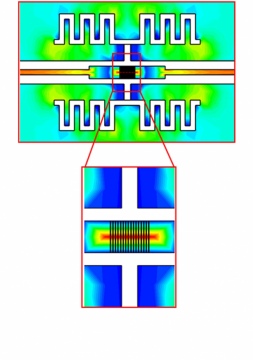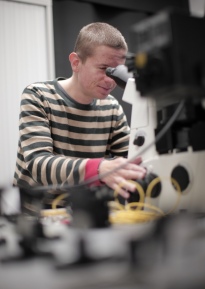

Scientists have developed a new way to create Terahertz waves (T-rays) that may one day lead to biomedical detective devices similar to the 'tricorder' scanner used in Star Trek - News release
A*STAR and Imperial College London news release
For immediate release
Friday 20 January 2012
Scientists have developed a new way to create electromagnetic Terahertz (THz) waves or T-rays - the technology behind full-body security scanners. The researchers behind the study, published recently in the journal Nature Photonics, say their new stronger and more efficient continuous wave T-rays could be used to make better medical scanning gadgets and may one day lead to innovations similar to the 'tricorder' scanner used in Star Trek.
See also:
Related news stories:
In the study, researchers from the Institute of Materials Research and Engineering (IMRE), a research institute of the Agency for Science, Technology and Research (A*STAR) in Singapore, and Imperial College London in the UK have made T-rays into a much stronger directional beam than was previously thought possible, and have done so at room-temperature conditions. This is a breakthrough that should allow future T-ray systems to be smaller, more portable, easier to operate, and much cheaper than current devices.
The scientists say that the T-ray scanner and detector could provide part of the functionality of a Star Trek-like medical 'tricorder' - a portable sensing, computing and data communications device - since the waves are capable of detecting biological phenomena such as increased blood flow around tumorous growths. Future scanners could also perform fast wireless data communication to transfer a high volume of information on the measurements it makes.
T-rays are waves in the far infrared part of the electromagnetic spectrum that have a wavelength hundreds of times longer than those that make up visible light. Such waves are already in use in airport security scanners, prototype medical scanning devices and in spectroscopy systems for materials analysis. T-rays can sense molecules such as those present in cancerous tumours and living DNA, since every molecule has its unique signature in the THz range. They can also be used to detect explosives or drugs, for gas pollution monitoring or non-destructive testing of semiconductor integrated circuit chips.

The electric field distribution generated by the antenna with close-up of nano-antennas
Current T-ray imaging devices are very expensive and operate at only a low output power, since creating the waves consumes large amounts of energy and needs to take place at very low temperatures.
In the new technique, the researchers demonstrated that it is possible to produce a strong beam of T-rays by shining light of differing wavelengths on a pair of electrodes - two pointed strips of metal separated by a 100 nanometre gap on top of a semiconductor wafer. The structure of the tip-to-tip nano-sized gap electrode greatly enhances the THz field and acts like a nano-antenna to amplify the wave generated. In this method, THz waves are produced by an interaction between the electromagnetic waves of the light pulses and a powerful current passing between the semiconductor electrodes. The scientists are able to tune the wavelength of the T-rays to create a beam that is useable in the scanning technology.
Lead author Dr Jing Hua Teng, from A*STAR’s IMRE, said: "The secret behind the innovation lies in the new nano-antenna that we had developed and integrated into the semiconductor chip." Arrays of these nano-antennas create much stronger THz fields that generate a power output that is 100 times higher than the power output of commonly used THz sources that have conventional interdigitated antenna structures. A stronger T-ray source renders the T-ray imaging devices more power and higher resolution.

Research author Professor Stefan Maier in the laboratory
Research co-author Stefan Maier, a visiting scientist at A*STAR’s IMRE and Professor in the Department of Physics at Imperial College London, said: "T-rays promise to revolutionise medical scanning to make it faster and more convenient, potentially relieving patients from the inconvenience of complicated diagnostic procedures and the stress of waiting for accurate results. Thanks to modern nanotechnology and nanofabrication, we have made a real breakthrough in the generation of T-rays that takes us a step closer to these new scanning devices. With the introduction of a gap of only 0.1 micrometers into the electrodes, we have been able to make amplified waves at the key wavelength of 1000 micrometers that can be used in such real world applications."
The research was led by scientist s from A*STAR’s IMRE and Imperial College London, and involved partners from A*STAR Institute for Infocomm Research (I2R) and the National University of Singapore. The research is funded under A*STAR’s Metamaterials Progr amme and the THz Programme, as well as the Leverhume Trust and the Engineering and Physical Sciences Research Council (EPSRC) in the UK.
- ENDS -
For further information please contact:
Simon Levey
Research Media Officer
Imperial College London
Email: s.levey@imperial.ac.uk
Tel: +44(0)20 7594 6702
Out of hours duty press officer: +44(0)7803 886 248
Mr Eugene Low
Manager, Corporate Communications
Institute of Materials Research and Engineering (IMRE)
Email: loweom@scei.a-star.edu.sg
Tel: +65 6874 8491
Mob: +65 9230 9235
Notes to editors:
1. Journal reference: "Greatly enhanced continuous-wave terahertz emission by nano-electrodes in a photoconductive photomixer" is published in Nature Photonics by H Tanoto, JH Teng, QY Wu, M Sun, ZN Chen, SA Maier, B Wang, CC Chum, GY Si, AJ Danner and SJ Chua. DOI:10.1038/nphoton.2011.322
2. About A*STAR
The Agency for Science, Technology and Research (A*STAR) is the lead agency for fostering world-class scientific research and talent for a vibrant knowledge-based and innovation-driven Singapore. A*STAR oversees 14 biomedical sciences and physical sciences and engineering research institutes, and six consortia & centres, located in Biopolis and Fusionopolis as well as their immediate vicinity.
A*STAR supports Singapore's key economic clusters by providing intellectual, human and industrial capital to its partners in industry. It also supports extramural research in the universities, hospitals, research centres, and with other local and international partners.
3. About Imperial College London
Consistently rated amongst the world's best universities, Imperial College London is a science-based institution with a reputation for excellence in teaching and research that attracts 14,000 students and 6,000 staff of the highest international quality. Innovative res earch at the College explores the interface between science, medicine, engineering and business, delivering practical solutions that improve quality of life and the environment - underpinned by a dynamic enterprise culture.
Since its foundation in 1907, Imperial's contributions to society have included the discovery of penicillin, the development of holography and the foundations of fibre optics. This commitment to the application of research for the benefit of all continues today, with current focuses including interdisciplinary collaborations to improve global health, tackle climate change, develop sustainable sources of energy and address security challenges.
In 2007, Imperial College London and Imperial College Healthcare NHS Trust formed the UK's first Academic Health Science Centre. This unique partnership aims to improve the quality of life of patients and populations by taking new discoveries and translating them into new therapies as quickly as possible.
- Website: www.imperial.ac.uk
- Twitter: www.twitter.com/imperialspark
- Podcast: www.imperial.ac.uk/media/podcasts
Article text (excluding photos or graphics) available under an Attribution-NonCommercial-ShareAlike Creative Commons license.
Photos and graphics subject to third party copyright used with permission or © Imperial College London.




